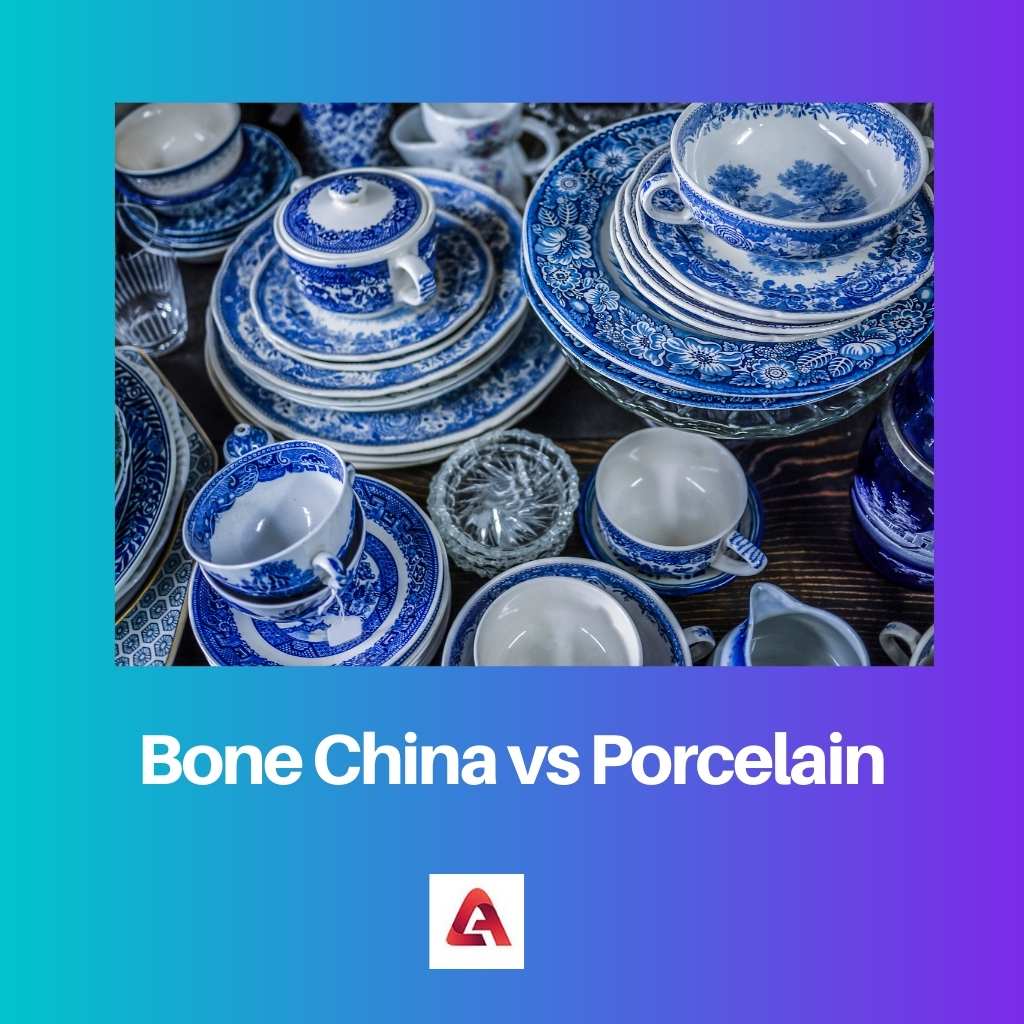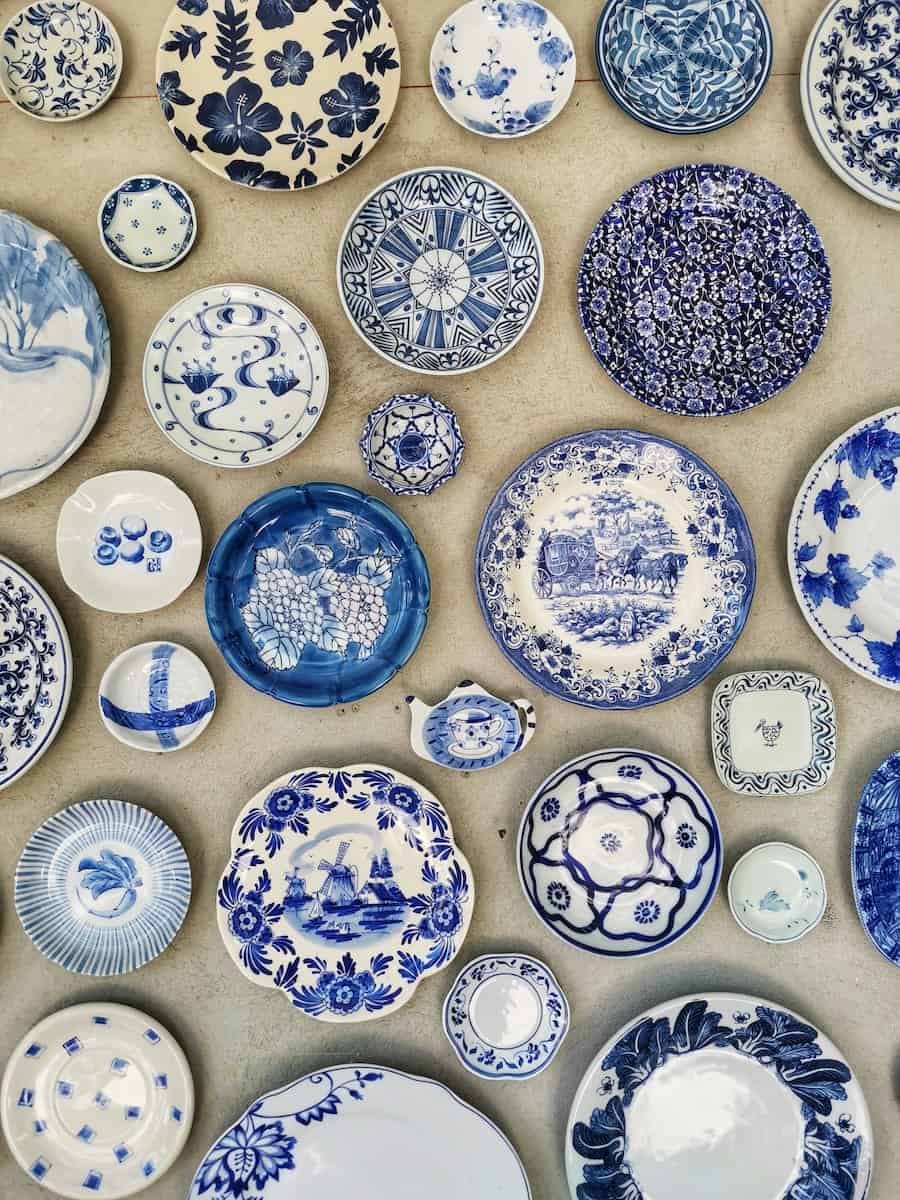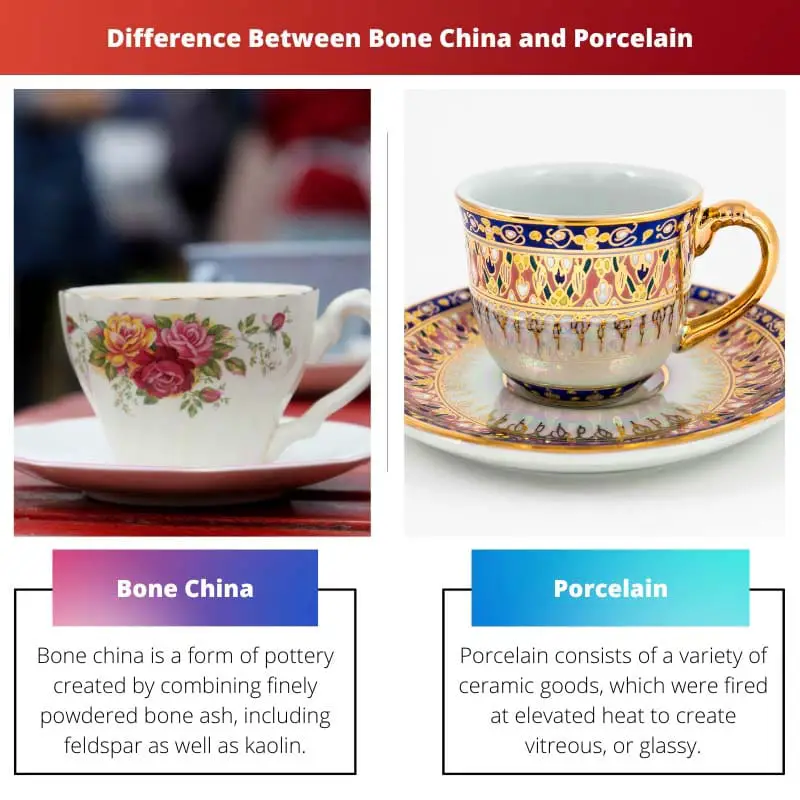Some individuals have difficulty distinguishing between bone china and porcelain because bone china is essentially a form of porcelain. There are, though, a few important distinctions to be made.
When it comes down to differentiating them based on their originality and basics, they are very different.
Key Takeaways
- Bone china is made from a mixture of bone ash, feldspar, and kaolin clay, giving it a translucent appearance and delicate feel.
- Porcelain is made from kaolin clay and is more durable than bone china.
- Bone china is more expensive than porcelain and is used for special occasions.
Bone China vs Porcelain
The difference between Bone China and Porcelain is that Porcelain doesn’t include bone ash, which is the primary distinction between itself and bone china. The majority of porcelains seem to be more delicate than bone china. On the other hand, owing to its notable translucent color derived out from bone ash constitution, bone china does have a smooth, sensitive appearance.

Bone china is a form of pottery created by combining finely powdered bone ash, including feldspar as well as kaolin. The phosphate level of bone ash is recommended to be preserved at or above 30%.
It’s being used to make high-end ceramics that have a dazzling milky white hue, are translucent, and are lighter but durable.
Porcelain consists of a variety of ceramic goods, which were fired at elevated heat to create vitreous, or glassy, properties like iridescent colors and low permeability. Table, as well as decorating china, chemical ware, dental crowns, as well as electrical contacts, are some of the most well-known porcelain products.
Comparison Table
| Parameters of Comparison | Bone China | Porcelain |
|---|---|---|
| Definition | Bone china is the most durable of the porcelain or even the china ceramics, with extremely high mechanical and tribological strength as well as chip tolerance. It is also recognized for its high levels of whiteness and transparency. | Porcelain is a term that is difficult to describe. It’s a particular type of earthenware. It’s a liquified clay body with little Fe2O3 impurity. |
| Techniques involved | The manufacture of bone china involves a number of techniques. Even before the slurry is formed into giant discs that are chopped and sculpted into dishes, bowls, mugs, and other items utilizing plaster moulds, the clay as well as bone ash should be blended with liquid. | After selecting the required raw materials and extracting the required quantities, they are exposed to a series of preparatory operations. |
| Formation Process | The stakes are taken out of the castings, given a vigorous wash to eliminate any excess clay, bumps, or other flaws, and then fired at around 2,300 degrees Fahrenheit in a kiln. | The raw components are combined before undergoing a series of formation processes. The sort of porcelain stoneware to be manufactured determines the shaping technique employed. |
| Heating and Glazing | The objects are smoothed after firing, then re-heated, glazed, and fired again to set the glaze in Bone China. After the items have already been glazed, they are either machines or hand-decorated. | The porcelain frame is heated after being created and can then be glazed. The technique of fusing a frosted glass coating into a ceramic system is known as glazing. |
| Mainly Distinguished on | The major difference between Bone China and Porcelain lies in the fact that the former uses real bones in its production. | Whereas, Porcelain doesn’t use animal bones in its manufacture. |
What is Bone China?
The term “bone china” comes from the fact that it is formed of bone ash. Animal remains, mainly cow bones, are powdered inside an ash form, and that’s what bone ashes are.
Bone china contains a certain proportion of bone ash, around 30% -45%, blended with additional elements such as quartz, kaolin (a kind of clay), feldspar, ball clay, silica, as well as other materials.
After that, the material is molded or formed into the appropriate shape and fired.
Firing is the procedure of hardening ceramics so that they can be used for meals and drinks. Bone china is special in that it can resist two firings in the kiln, which would be a ceramics-firing furnace.
The very first fire phase shrinks the chunk of bone china, as well as phase two fuses the glazing towards the china, making itself a chunk. Vintage fine bone china can be extremely valuable, especially if it’s a one-of-a-kind item from a well-known manufacturer.

What is Porcelain?
Porcelain has been doing this for about the year620, with far more modern processes and blends being used around the year 1279. Pegmatite (a sort of granite), as well as kaolin, were used to make the very first porcelains, which have created in China (clay).
German producers began implementing feldspar rather than glass around 1707, and the trend has persisted until this very day. The necessary components are crushed, cleansed, formed, and incinerated with care.
Porcelain begins with a lump of light clay, like china white, that seems to have small, tightly packed granules that are crushed to make them even.
“Completely vitrified, rigid, impervious (well before glaze), white or deliberately pigmented, translucent (unless when of great volume), as well as resonant” are some of the characteristics of porcelain. Nevertheless, the label “porcelain” lacks a broad concept and also has “been extended in an ad hoc manner to a wide range of material with just superficial similarities.”

Main Differences Between Bone China and Porcelain
- With extraordinarily high mechanical characteristics strength, along with chip sensitivity, bone china is perhaps the most enduring of the porcelain or maybe even china ceramics. It’s also known for having a lot of whiteness and openness. Porcelain is a complex notion. It’s a specific kind of earthenware. It’s a liquid clay body with a small amount of Fe2O3 impurities.
- A variety of processes are used in the production of bone china. The clay and bone ash must be combined with liquid since before the sludge is shaped into huge discs that are sliced and molded into dishes, bowls, mugs, and some other items using plaster casts. They are subjected to a variety of planning phases after selecting the appropriate raw ingredients and obtaining the amount needed.
- The stakes are removed from the Bone China castings, given a thorough wash to remove any excess clay, irregularities, or other faults, and then burned in a kiln at a temperature of roughly 2,300 degrees Fahrenheit. Porcelain, from the other end, starts with raw materials that are mixed together before going through a series of forming procedures. The sculpting process used is determined by the type of porcelain stoneware being produced.
- After firing, the items are polished, then re-heated, glossed, and fired once more to fix the glaze in Bone China. The objects are either machinery or hand-embellished after they’ve been glazed. After being produced, the porcelain framework is heated before being glazed. Cladding is the process of welding a frosted glass layer to a ceramic structure.
- The main difference between Bone China as well as Porcelain is that the former is made from real bones while the latter is made from clay. Porcelain, on the other hand, does not require skeletal remains in its production.

- https://www.researchgate.net/profile/S-Braganca/publication/289482637_A_comparative_study_between_bone_China_and_hard_porcelain/links/5a0b0336a6fdccc69ed9d0e6/A-comparative-study-between-bone-China-and-hard-porcelain.pdf
- https://journals.utm.my/jurnalteknologi/article/view/2157
